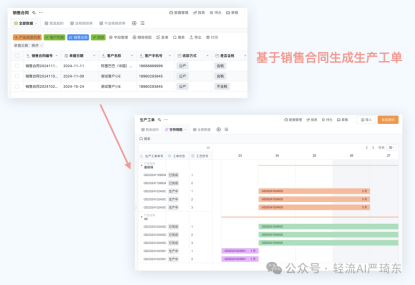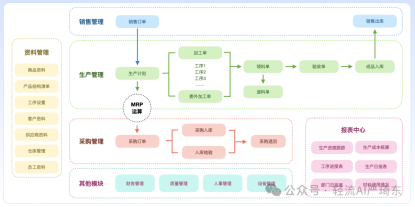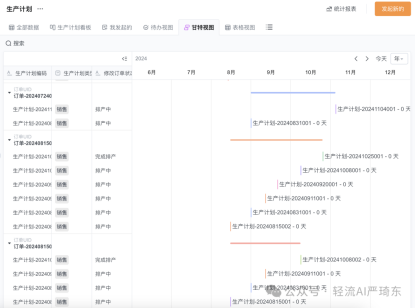A. Key Challenges in Production Planning and Equipment Management
In the realm of enterprise production management, companies encounter a multitude of difficulties that impede their efficiency and profitability. The complexity of modern production processes, combined with the ever - changing market demands, makes it challenging to develop and execute effective production plans. Meanwhile, aging equipment, lack of real - time monitoring, and improper maintenance strategies often lead to unexpected breakdowns and costly downtime.
The main pain points include:
- Inaccurate Production Planning: Many companies struggle to create precise production plans due to a lack of comprehensive data, poor forecasting methods, and the inability to adapt to sudden changes in demand.
- Inefficient Equipment Utilization: Equipment may not be used to its full potential, resulting in wasted resources and increased costs. This can be due to improper scheduling, lack of training, or suboptimal equipment layout.
- High Equipment Maintenance Costs: Traditional equipment maintenance approaches are often reactive, leading to higher costs and more frequent breakdowns. Without proactive maintenance strategies, companies may face unexpected production halts.
- Weak Material Coding in Traditional Systems: Traditional ERP software often has limited material coding capabilities, relying on manual labor for coding, which is time - consuming and error - prone.
These pain points collectively create significant obstacles for companies, hindering their ability to meet production targets, control costs, and maintain a competitive edge in the market.
B. Case Analysis of Pain Points
- Inaccurate Production Planning In real - world production scenarios, inaccurate production planning can lead to a series of problems. For example, when a company fails to accurately forecast demand, it may over - produce, resulting in excess inventory and increased storage costs. On the other hand, under - production can lead to missed delivery deadlines, dissatisfied customers, and lost business opportunities.
For instance, consider a manufacturing company that produces consumer electronics. Due to inaccurate demand forecasting, the company over - produced a particular model of smartphones. As a result, they had a large inventory of unsold phones, tying up a significant amount of capital. At the same time, they were unable to quickly adjust production to meet the demand for a new, more popular model, losing market share to competitors. 2. Inefficient Equipment Utilization Inefficient equipment utilization can have a direct impact on a company's bottom line. When equipment is not used efficiently, it not only wastes resources but also increases production time and costs. For example, in a factory, if machines are not properly scheduled, they may sit idle for long periods, while other machines are over - utilized, leading to premature wear and tear.
Take a textile manufacturing plant as an example. The plant had a set of weaving machines that were not being used to their full capacity due to poor scheduling. Some machines were running at half - speed, while others were overloaded. This not only reduced the overall production output but also increased the energy consumption and maintenance costs of the machines. 3. High Equipment Maintenance Costs High equipment maintenance costs can be a major burden for companies. Reactive maintenance, where equipment is only repaired after it breaks down, often leads to more extensive damage and higher repair costs. Moreover, unexpected breakdowns can cause production delays, resulting in lost revenue.
For example, in a chemical processing plant, a key piece of equipment broke down suddenly. Since there was no proactive maintenance plan in place, the repair took several days, causing a significant disruption to the production process. The cost of the repair, combined with the lost production during the downtime, was extremely high. 4. Weak Material Coding in Traditional Systems Traditional ERP software's weak material coding capabilities can cause inefficiencies in the production process. Manual material coding is time - consuming and prone to errors, which can lead to incorrect inventory management, production delays, and increased costs.
For example, in a company that produces industrial machinery, the traditional ERP software could not automatically generate material codes. Employees had to manually assign codes to each part, which was a labor - intensive process. As a result, there were often errors in the coding, leading to issues such as incorrect parts being ordered, delays in production, and confusion in the inventory system.
C. Available Solutions for Production Planning and Equipment Challenges
- Advanced Production Planning Software Advanced production planning software is designed to help companies create more accurate and flexible production plans. These software solutions use advanced algorithms and data analytics to analyze historical data, market trends, and production capacity. They can generate optimized production schedules, taking into account factors such as order priority, equipment availability, and labor resources.
This software solves the problem of inaccurate production planning by providing real - time data and insights. It allows companies to quickly adjust production plans in response to changes in demand, reducing the risk of over - or under - production. However, these software solutions can be expensive to implement and may require significant training for employees to use effectively. 2. Equipment Monitoring and Management Systems Equipment monitoring and management systems use sensors and IoT technology to collect real - time data on equipment performance. These systems can track parameters such as temperature, vibration, and energy consumption, enabling companies to detect potential problems before they cause breakdowns.
By providing early warnings, these systems help companies implement proactive maintenance strategies, reducing equipment downtime and maintenance costs. However, the installation and integration of these systems can be complex, and they may require continuous data management and analysis. 3. Predictive Maintenance Tools Predictive maintenance tools use machine learning algorithms to analyze equipment data and predict when maintenance is required. These tools can identify patterns and anomalies in equipment performance, allowing companies to schedule maintenance at the most appropriate time.
This approach helps to reduce maintenance costs by avoiding unnecessary maintenance and preventing unexpected breakdowns. However, developing and implementing predictive maintenance models requires a large amount of historical data and technical expertise. 4. No - code Platform: Wingent Wingent offers a comprehensive solution to the production planning and equipment management challenges faced by enterprises. It can streamline processes, improve efficiency, and reduce costs without the need for extensive coding knowledge.
D. How Wingent Solves Production Planning and Equipment Challenges
Wingent is a powerful no - code platform that can effectively address the pain points in production planning and equipment management. With its intuitive interface and flexible functionality, Wingent enables companies to build customized production management systems tailored to their specific needs.
- Accurate Production Planning
Wingent allows companies to integrate various data sources, such as sales orders, inventory levels, and production capacity, to generate accurate production plans. By using data - driven algorithms, it can analyze historical data and market trends to forecast demand more precisely. For example, it can consider factors like seasonality, customer preferences, and economic indicators to adjust production schedules in real - time.
 This helps companies avoid over - or under - production, reducing inventory costs and improving customer satisfaction. In some cases, companies using Wingent have reported a 20% increase in production plan accuracy, leading to a significant reduction in inventory waste.
This helps companies avoid over - or under - production, reducing inventory costs and improving customer satisfaction. In some cases, companies using Wingent have reported a 20% increase in production plan accuracy, leading to a significant reduction in inventory waste. - Efficient Equipment Utilization
Wingent can optimize equipment scheduling by considering factors such as equipment availability, maintenance schedules, and production priorities. It can create a unified view of all equipment in the production process, allowing managers to make informed decisions about equipment allocation.
 For example, it can identify bottlenecks in the production process and suggest ways to re - allocate equipment to improve overall efficiency. By using Wingent, companies can increase equipment utilization rates by up to 15%, resulting in higher productivity and lower costs.
For example, it can identify bottlenecks in the production process and suggest ways to re - allocate equipment to improve overall efficiency. By using Wingent, companies can increase equipment utilization rates by up to 15%, resulting in higher productivity and lower costs. - Proactive Equipment Maintenance
Wingent supports the implementation of proactive equipment maintenance strategies. It can integrate with equipment monitoring sensors to collect real - time data on equipment performance. Based on this data, it can predict potential equipment failures and schedule maintenance in advance.
 This reduces the likelihood of unexpected breakdowns and minimizes production downtime. Some companies have seen a 30% reduction in equipment maintenance costs after implementing Wingent's proactive maintenance features.
This reduces the likelihood of unexpected breakdowns and minimizes production downtime. Some companies have seen a 30% reduction in equipment maintenance costs after implementing Wingent's proactive maintenance features. - Automated Material Coding
Wingent's "data association" and "association with existing data" functions can solve the problem of weak material coding in traditional systems. It can automatically generate material codes based on predefined rules, eliminating the need for manual coding.
 This improves the accuracy and efficiency of inventory management and production processes. For example, in a company using Wingent, the time spent on material coding was reduced by 80%, and the accuracy of material coding increased significantly.
This improves the accuracy and efficiency of inventory management and production processes. For example, in a company using Wingent, the time spent on material coding was reduced by 80%, and the accuracy of material coding increased significantly.
In summary, Wingent provides a comprehensive and efficient solution to the key challenges in production planning and equipment management. It empowers companies to optimize their production processes, reduce costs, and enhance their competitiveness in the market.
结语
In conclusion, the challenges of production planning and equipment management are significant hurdles for enterprises. Inaccurate production plans, inefficient equipment utilization, high maintenance costs, and weak material coding in traditional systems can all impede a company's growth and profitability. However, with the right solutions, these challenges can be overcome.
Wingent offers a powerful and flexible no - code platform that addresses these pain points head - on. By enabling accurate production planning, efficient equipment utilization, proactive maintenance, and automated material coding, Wingent helps companies streamline their operations, reduce costs, and improve overall productivity.
Reference:
[1] 2小时,我搭建了一个生产管理系统,包含排程、质量、物料、设备、报工等多模块 https://mp.weixin.qq.com/s/G6BG0ez8vV93nBS4BhbWtQ
[2] 7大维度,中小制造业企业如何选择生产管理系统? https://mp.weixin.qq.com/s/pm14LCcwxlHfMKRHAgkEFQ
[3] 生产计划、排产调度、现场管控、质量管理怎么做?一文看懂生产全流程管理 https://mp.weixin.qq.com/s/DR2qqMLPuA4ADOOJvtuLPw
[4] 生产设备管理:一全、二实、三预、四驱、五联 https://mp.weixin.qq.com/s/slh_SRaDdwl07yYTLHcPUg
[5] 安全生产管理的 一核、二防、三查、四管、五素 https://mp.weixin.qq.com/s/Bw7o19jS_NqVrTLxZ2FVug
[6] 3000字把怎么做设备档案、巡检、报修、保养讲清楚了 https://mp.weixin.qq.com/s/uxhoGdjN9JrN3XGpw6XDMA